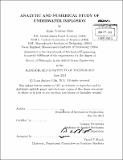| dc.contributor.advisor | Tomasz Wierzbicki. | en_US |
| dc.contributor.author | Gish, Lynn Andrew | en_US |
| dc.contributor.other | Massachusetts Institute of Technology. Department of Mechanical Engineering. | en_US |
| dc.date.accessioned | 2013-10-24T17:45:39Z | |
| dc.date.available | 2013-10-24T17:45:39Z | |
| dc.date.copyright | 2013 | en_US |
| dc.date.issued | 2013 | en_US |
| dc.identifier.uri | http://hdl.handle.net/1721.1/81699 | |
| dc.description | Thesis (Ph. D.)--Massachusetts Institute of Technology, Dept. of Mechanical Engineering, 2013. | en_US |
| dc.description | Cataloged from PDF version of thesis. | en_US |
| dc.description | Includes bibliographical references (p. 203-205). | en_US |
| dc.description.abstract | Underwater implosion, the rapid collapse of a structure caused by external pressure, generates a pressure pulse in the surrounding water that is potentially damaging to adjacent structures or personnel. Understanding the mechanics of implosion, specifically the energy transmitted in the pressure pulse, is critical to the safe and efficient design of underwater structures. Hydrostatically-induced implosion of unstiffened metallic cylinders was studied both analytically and numerically. An energy balance approach was used, based on the principle of virtual velocities. Semi-analytic solutions were developed for plastic energy dissipation of a symmetric mode 2 collapse; results agree with numerical simulations within 10%. A novel pseudo-coupled fluid-structure interaction method was developed to predict the energy transmitted in the implosion pulse; results agree with fully-coupled numerical simulations within 6%. The method provides a practical alternative to computationally-expensive simulations when a minimal reduction in accuracy is acceptable. Three design recommendations to reduce the severity of implosion are presented: (1) increase the structure's internal energy dissipation by triggering higher collapse modes, (2) initially pressurize the internals of the structure, and (3) line the cylinder with a flexible or energy absorbing material to cushion the impact between the structure's imploding walls. These recommendations may be used singly or in combination to reduce or completely eliminate the implosion pulse. However, any design efforts to reduce implosion severity must be part of the overall system design, since they may have detrimental effects on other performance areas like strength or survivability. | en_US |
| dc.description.statementofresponsibility | by Lynn Andrew Gish. | en_US |
| dc.format.extent | 205 p. | en_US |
| dc.language.iso | eng | en_US |
| dc.publisher | Massachusetts Institute of Technology | en_US |
| dc.rights | M.I.T. theses are protected by
copyright. They may be viewed from this source for any purpose, but
reproduction or distribution in any format is prohibited without written
permission. See provided URL for inquiries about permission. | en_US |
| dc.rights.uri | http://dspace.mit.edu/handle/1721.1/7582 | en_US |
| dc.subject | Mechanical Engineering. | en_US |
| dc.title | Analytic and numerical study of underwater implosion | en_US |
| dc.type | Thesis | en_US |
| dc.description.degree | Ph.D. | en_US |
| dc.contributor.department | Massachusetts Institute of Technology. Department of Mechanical Engineering | |
| dc.identifier.oclc | 860901643 | en_US |
